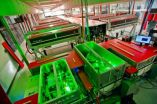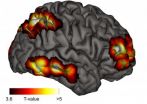(Press-News.org) An international team of researchers from the USA and Europe including from the University of Bonn under the direction of Dr. Hugues Sana (University of Amsterdam) has discovered that the most massive stars in the universe don't spend their lives in space as singles as was previously thought. More than two-thirds orbit a partner star. "The orbit paths of the stars are very close together so that the region around these stars is turbulent and by far not as calm as previously thought," says Professor Norbert Langer from the University of Bonn. What happens is that one star can suck the material out of its companion like a vampire or both stars can melt to become an even larger massive star. This is revealed in a current study on the lives of massive stars, a study which Dr. Norbert Langer, Prof. Dr. Robert Izzard and Fabian Schneider worked on together with three other scientists from the Argelander Institute for Astronomy at the University of Bonn.
Ten years of observations using one of the world's largest telescopes
Astronomers evaluated more than ten years' worth of observations using one of the world's largest telescopes, the Very Large Telescope (VLT) in Chile's Atacama Desert. "The spectacular new research findings could only have been gathered based on one of the most extensive observation campaigns in this area," says Professor Robert Izzard. A total of 71 massive stars in six young galactic star clusters were observed for years. Through close-knit monitoring, researchers were able to determine the paths of over three-quarters of the double stars discovered which led to unique precision. "The current study reveals that the fast majority of all massive stars spend their lives with a partner," states Fabian Schneider, the third scientist based in Bonn. Over time, roughly one-third of the star systems melts with their companion, while the other two-thirds transfer material to its partner.
Gigantic explosions at the end of star's life
Massive stars, also called spectral class O stars because of their characteristics are the brightest and the most short-lived stars in the universe. In the beginning they are more than 15 times as massive as our Sun. The end of their life is marked by spectacular supernova explosions or gamma ray bursts. They account for a large part of all the heavy elements in the universe. "The new insight into the lives of massive stars has a direct impact on the understanding of the final stages most massive stars experience," says Professor Langer. The gigantic explosions at the end of a star's life can be observed from almost all corners of the universe. This underscores the importance of the new findings which have now been published
### Publication: H. Sana et al., Science, July 27, 2012 (DOI 10.1126/science.1223344)
Contact:
Argelander Institute for Astronomy at the University of Bonn
Prof. Dr. Norbert Langer
Tel.: 0228/73-3656 or 73-3655
E-Mail: nlanger@astro.uni-bonn.de
Prof. Dr. Robert Izzard
Tel.: 0228/73-1773
E-Mail: izzard@astro.uni-bonn.de
Fabian Schneider
Tel.: 0228/73-3391
E-Mail: fschneid@astro.uni-bonn.de
Turbulent relationship among massive stars
Most massive stars orbit a partner - Science study involving the University of Bonn
2012-07-27
ELSE PRESS RELEASES FROM THIS DATE:
Nano-FTIR - A new era in modern analytical chemistry
2012-07-27
An ultimate goal in modern chemistry and materials science is the non-invasive chemical mapping of materials with nanometer scale resolution. A variety of high-resolution imaging techniques exist (e.g. electron microscopy or scanning probe microscopy), however, their chemical sensitivity cannot meet the demands of modern chemical nano-analytics. Optical spectroscopy, on the other hand, offers high chemical sensitivity but its resolution is limited by diffraction to about half the wavelength, thus preventing nanoscale resolved chemical mapping.
Nanoscale chemical identification ...
BELLA laser achieves world record power at 1 pulse per second
2012-07-27
On the night of July 20, 2012, the laser system of the Berkeley Lab Laser Accelerator (BELLA), which is nearing completion at the U.S. Department of Energy's Lawrence Berkeley National Laboratory (Berkeley Lab), delivered a petawatt of power in a pulse just 40 femtoseconds long at a pulse rate of one hertz – one pulse every second. A petawatt is 1015 watts, a quadrillion watts, and a femtosecond is 10-15 second, a quadrillionth of a second. No other laser system has achieved this peak power at this rapid pulse rate.
"This represents a new world record," said Wim Leemans ...
Study finds gaps in services for heterosexual men with HIV
2012-07-27
TORONTO, July 27,2012 –Heterosexual men make up a small but growing number of people infected with HIV in Canada.
Yet a new study has found that many of them feel existing HIV-related programs and services don't meet their needs and are geared primarily or exclusively toward gay men and heterosexual women who are living with the virus.
"Heterosexual men tend to go through HIV alone," said Tony Antoniou, a pharmacist and research scholar in the Department of Family Medicine at St. Michael's Hospital. "They feel very isolated."
Antoniou said the study, published in the ...
Study: Group yoga improves motor function and balance long after stroke
2012-07-27
INDIANAPOLIS -- Group yoga can improve motor function and balance in stroke survivors, even if they don't begin yoga until six months or more after the stroke, according to "Post-Stroke Balance Improves With Yoga: A Pilot Study," published online July 26 in the journal Stroke.
Forty-seven older adults, three-quarters of whom were male, participated in the study. They were divided into three sections: One section engaged in twice-weekly group yoga for eight weeks; the second section met twice weekly for group yoga and was provided with a relaxation audio recording to ...
Higgs excitations
2012-07-27
Phase transitions between different states of matter can be associated with a specific type of excitation called the "Higgs excitation". This phenomenon has now been ob-served in a two-dimensional quantum gas at temperatures near absolute zero.
In physics spontaneous symmetry breaking is a fundamental feature of transitions between different states of matter. An example of this phenomenon is the abrupt alignment of spin orientation in a ferromagnetic substance when the material is cooled below the so-called Curie temperature. Phase transitions introduce a new degree of ...
Turbulences at a standstill
2012-07-27
For theoretical physicist Dima Shepelyansky from the CNRS-University of Toulouse, France, devising models of chaos and turbulence is his bread and butter. In a recent study published in EPJ B¹, he presents an exception he found in a model of turbulence, indicating that there are energy flows from large to small scale in confined space. Indeed, under a specific energy threshold, there are no energy flows, similar to the way electron currents and energy spreading are stopped in disordered solids.
The author relies on numerical simulations to study a kind of turbulence—known ...
'Diving board' sensors key to DNA detection
2012-07-27
PHILADELPHIA - A tiny vibrating cantilever sensor could soon help doctors and field clinicians quickly detect harmful toxins, bacteria and even indicators of certain types of cancer from small samples of blood or urine. Researchers from Drexel University are in the process of refining a sensor technology that they developed to measure samples at the cellular level into an accurate method for quickly detecting traces of DNA in liquid samples.
According to lead researcher Dr. Raj Mutharasan, a professor in Drexel's College of Engineering, the group's unique application ...
The longer you're awake, the slower you get
2012-07-27
Boston, MA – Anyone that has ever had trouble sleeping can attest to the difficulties at work the following day. Experts recommend eight hours of sleep per night for ideal health and productivity, but what if five to six hours of sleep is your norm? Is your work still negatively affected? A team of researchers at Brigham and Women's Hospital (BWH) have discovered that regardless of how tired you perceive yourself to be, that lack of sleep can influence the way you perform certain tasks.
This finding is published in the July 26, 2012 online edition of The Journal of ...
The seat of meta-consciousness in the brain
2012-07-27
This press release is available in German.
Which areas of the brain help us to perceive our world in a self-reflective manner is difficult to measure. During wakefulness, we are always conscious of ourselves. In sleep, however, we are not. But there are people, known as lucid dreamers, who can become aware of dreaming during sleep. Studies employing magnetic resonance tomography (MRT) have now been able to demonstrate that a specific cortical network consisting of the right dorsolateral prefrontal cortex, the frontopolar regions and the precuneus is activated when this ...
Boys' impulsiveness may result in better math ability, say MU researchers
2012-07-27
COLUMBIA, Mo. – In a University of Missouri study, girls and boys started grade school with different approaches to solving arithmetic problems, with girls favoring a slow and accurate approach and boys a faster but more error prone approach. Girls' approach gave them an early advantage, but by the end of sixth grade boys had surpassed the girls. The MU study found that boys showed more preference for solving arithmetic problems by reciting an answer from memory, whereas girls were more likely to compute the answer by counting. Understanding these results may help teachers ...
LAST 30 PRESS RELEASES:
Numbers in our sights affect how we perceive space
SIMJ announces global collaborative book project in commemoration of its 75th anniversary
Air pollution exposure and birth weight
Obstructive sleep apnea risk and mental health conditions among older adults
How talking slows eye movements behind the wheel
The Ceramic Society of Japan’s Oxoate Ceramics Research Association launches new international book project
Heart-brain connection: international study reveals the role of the vagus nerve in keeping the heart young
Researchers identify Rb1 as a predictive biomarker for a new therapeutic strategy in some breast cancers
Survey reveals ethical gaps slowing AI adoption in pediatric surgery
Stimulant ADHD medications work differently than thought
AI overestimates how smart people are, according to HSE economists
HSE researchers create genome-wide map of quadruplexes
Scientists boost cell "powerhouses" to burn more calories
Automatic label checking: The missing step in making reliable medical AI
Low daily alcohol intake linked to 50% heightened mouth cancer risk in India
American Meteorological Society announces Rick Spinrad as 2026 President-Elect
Biomass-based carbon capture spotlighted in newly released global climate webinar recording
Illuminating invisible nano pollutants: advanced bioimaging tracks the full journey of emerging nanoscale contaminants in living systems
How does age affect recovery from spinal cord injury?
Novel AI tool offers prognosis for patients with head and neck cancer
Fathers’ microplastic exposure tied to their children’s metabolic problems
Research validates laboratory model for studying high-grade serous ovarian cancer
SIR 2026 delivers transformative breakthroughs in minimally invasive medicine to improve patient care
Stem Cell Reports most downloaded papers of 2025 highlight the breadth and impact of stem cell research
Oxford-led study estimates NHS spends around 3% of its primary and secondary care budget on the health impacts of heat and cold in England
A researcher’s long quest leads to a smart composite breakthrough
Urban wild bees act as “microbial sensors” of city health.
New study finds where you live affects recovery after a hip fracture
Forecasting the impact of fully automated vehicle adoption on US road traffic injuries
Alcohol-related hospitalizations from 2016 to 2022
[Press-News.org] Turbulent relationship among massive starsMost massive stars orbit a partner - Science study involving the University of Bonn




